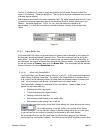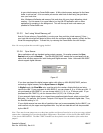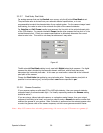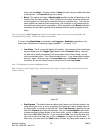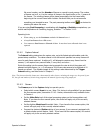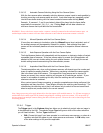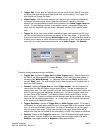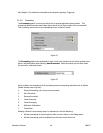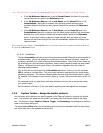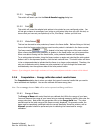3.2.4.3.3 Automatic Camera Switching Using the Four Camera Option
With the four-camera option automatic switching between camera inputs is made possible by
checking more than one camera enable at a time. Input data frames are repeatedly cycled
into the frame buffer starting with the lowest numbered camera after clicking Start!
Example: If cameras 1, 3 and 4 are checked; data will be placed into the frame buffer
sequentially from camera 1,3,4,1,3,4…, etc. Clicking Stop! will halt data collection at
whichever camera last input data into the frame buffer.
WARNING: Do not check on a camera unless a camera is actually connected to the indicated camera input. An
enabled input without a camera will cause data collection to stall when the nonexistent camera is selected.
.
3.2.4.3.4 Ultracal Operation with the Four Camera Option
If more than one camera is checked on when the Ultracal! menu item is activated, each of
the enabled cameras will be separately Ultracal’d in rotation. Data collected from each
camera will be individually baseline corrected according to its respective Ultracal reference
frame.
3.2.4.3.5 Auto-Exposure Operation with the Four Camera Option
The Auto-Exposure feature will automatically set the exposure or electronic shutter of certain
compatible types of cameras. If the four-camera option is present the LBA application will
attempt to find a correct shutter setting for each enabled camera. It will apply the correct
shutter setting to each camera during the data collection process.
3.2.4.3.6 Acquisition Rate Effects with the Four Camera Option
The data acquisition rate, when cycling between cameras, will depend upon the number and
types of enabled processing features. Without any processing overhead the camera switch
rate is the frame rate of the camera. This means that if one camera can be input at 30
frames per second, then camera switching will progress at 30 switches per second. If your
system is not capable of sustaining this rate, then the resulting rate will be whatever
maximum rate can be sustained.
When various types of image processing, or complex computations are being performed, the
acquisition rate may slow down. These effects will delay the switching rate accordingly. The
rule affecting the switching rate is that it will take as long to switch to the next camera as it
takes to acquire and process data for the current camera.
Note: Image processing rules apply identically to the data inputs of all enabled cameras. I.e. If frame averaging is
enabled then each camera input will be frame averaged before switching to the next camera. It is not possible to
average inputs from multiple cameras during the data collection process. However this can be done using the Post
Processing feature.
3.2.4.4 Trigger
The Trigger panel in the Capture dialog box allows you to selectively control when an image is
to be captured by the LBA. The selected trigger Type will govern which of the other selections
you will need to make. The four Type choices are:
• CW: Choose this type if your laser operates in a continuous wave manner, or pulses at a
repetition rate that will appear to your video camera as continuous. In CW mode, none
of the other settings in this panel are applicable.
Operator’s Manual LBA-PC
62



